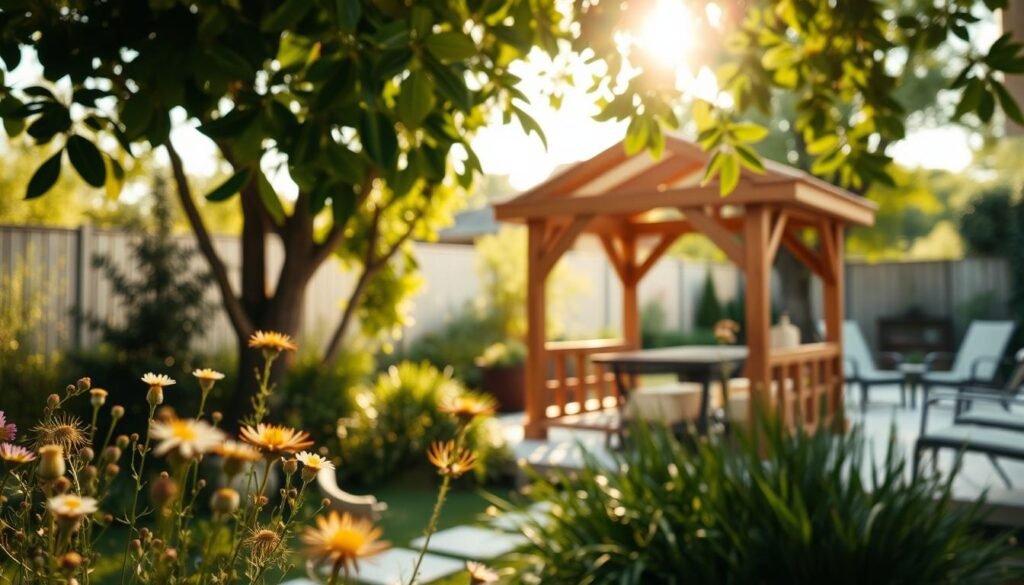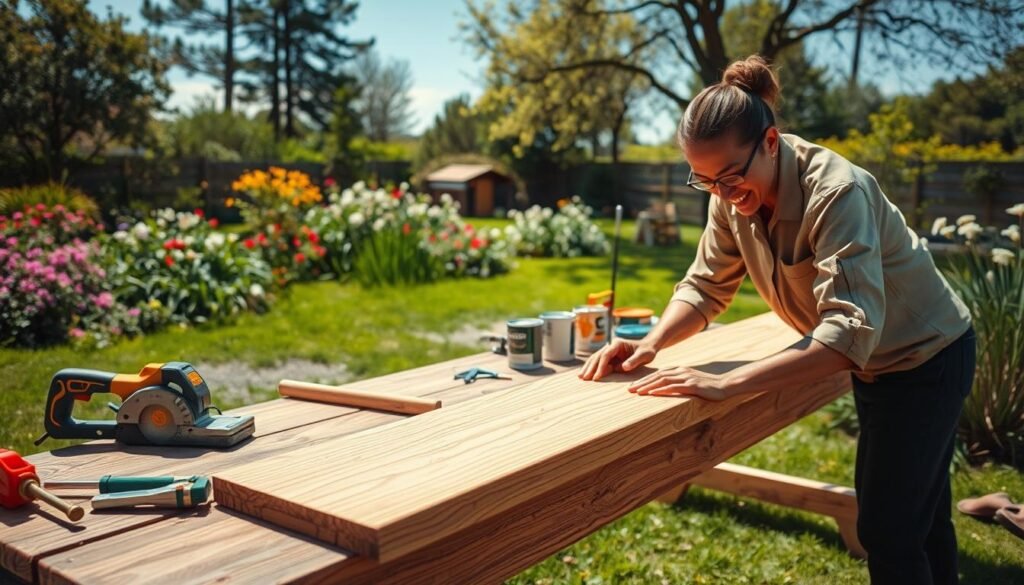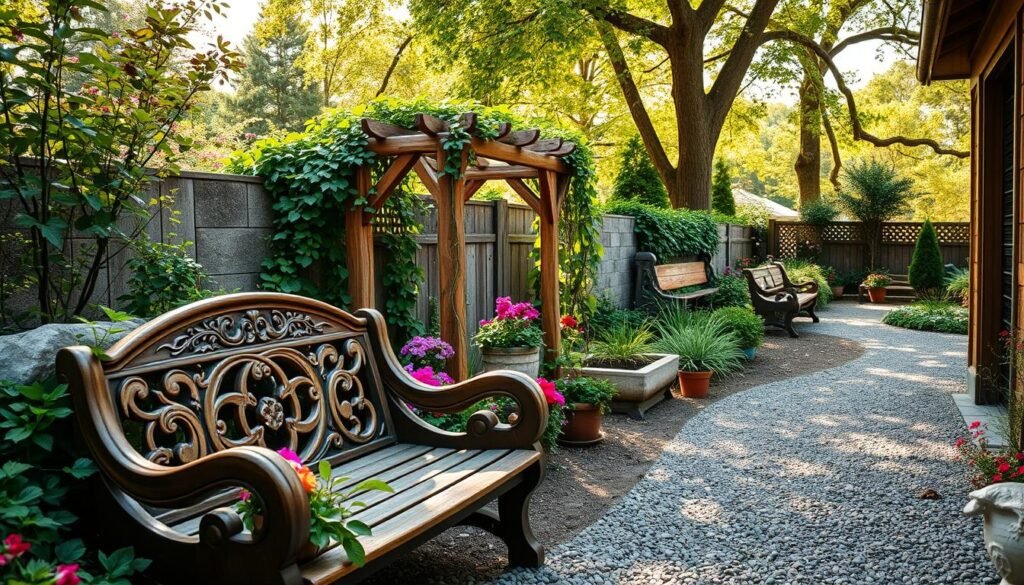Turning your outdoor area into a beautiful oasis is easier than you think. With a little creativity and some simple DIY gardening techniques, you can create a stunning outdoor area. It’s perfect for relaxation and entertainment.
Whether you’re looking to add some color with vibrant flowers or create a functional outdoor living space, easy DIY garden projects can help you achieve your goals. From outdoor diy decor to functional gardening solutions, the possibilities are endless. We’ll explore some inspiring ideas to get you started.
Transform Your Outdoor Space with Simple DIY Ideas
Make your outdoor living better with simple DIY garden ideas. These can change your backyard into a special place that shows your style. It’s all about making your space unique.
Benefits of Creating Your Own Garden Features
Building your own garden features saves money and lets you show your creativity. It’s a fun way to make your outdoor area just right for you. Plus, it’s rewarding to see your hard work come to life.
Essential Tools and Materials for Beginners
To start DIY garden projects, you need basic tools and materials. You’ll need a shovel, rake, and gloves. Also, you might use wood, stone, or recycled items, depending on your project.
Planning Your Garden Transformation
Before starting, plan your garden makeover carefully.
Assessing Your Space and Needs
Look at your outdoor area, thinking about sunlight, soil, and what’s already there. Decide how you’ll use your garden and what features you need.
Setting a Realistic Timeline and Budget
Figure out a timeline and budget that fit your needs. This way, your garden ideas won’t cost too much.
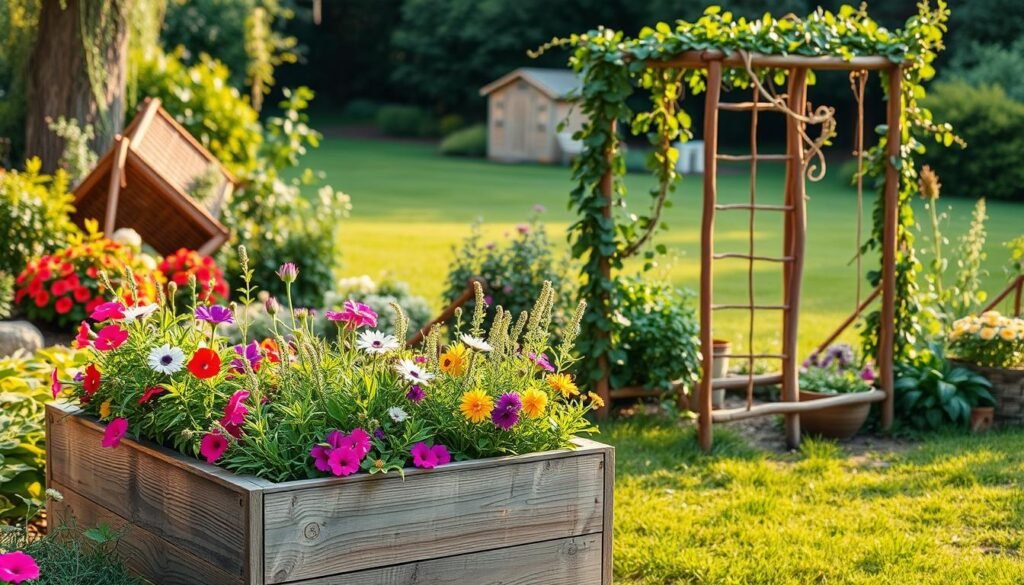
By following these steps and using creative ideas, you can turn your outdoor space into a beautiful area. It will be a place you’ll love for many years.
Budget-Friendly Garden Projects for Every Skill Level
Turning your garden into a paradise doesn’t have to cost a lot. Many affordable projects are waiting for you, no matter your gardening level. You can make your outdoor space better without spending too much.
Weekend Projects Under $50
With projects under $50, you can change your garden in just a weekend. You can build planters or make garden markers. These are great DIY ideas for your garden.
One-Hour Garden Enhancements
Need a quick garden update? Try one-hour projects. Simple changes like rearranging your garden or adding outdoor decor can make a big difference.
Family-Friendly Activities
Getting your family involved in gardening is fun and educational. You can build a fairy garden or make decorations together. It’s a great way to spend time together.
Seasonal Project Planning
Plan your garden projects by season to save time and money. Spring is best for planting, and autumn is great for harvesting and preparing for next year.
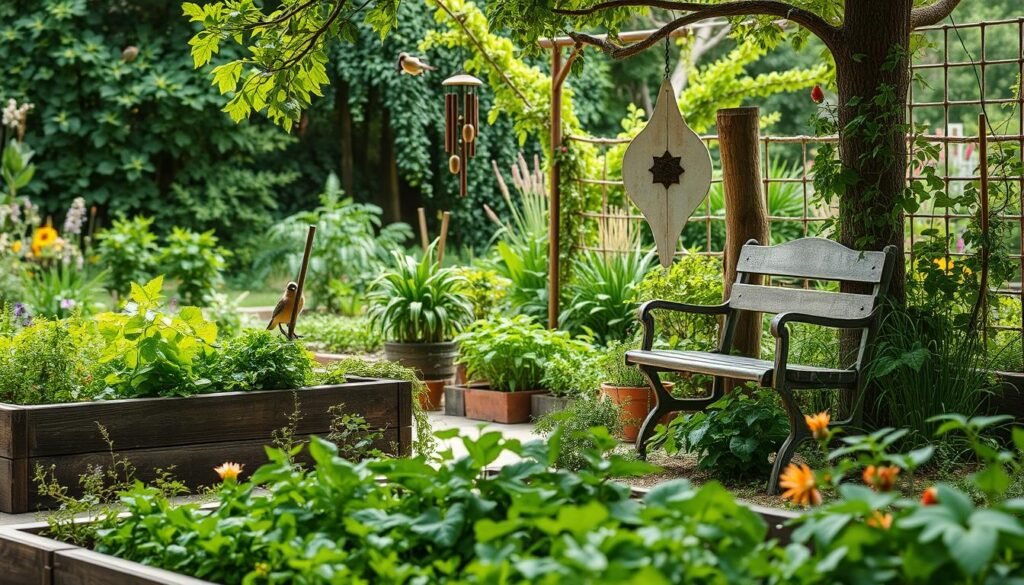
Safety Considerations for DIY Gardeners
Always put safety first when gardening DIY. Wear protective gear, follow instructions, and use tools right to avoid accidents.
By using these budget-friendly and eco-friendly gardening tips, you can create a beautiful outdoor space. It will show your style without costing a lot.
Creating Beautiful Container Gardens for Any Space
Container gardens can make any outdoor space look great, whether you have a big backyard or a small balcony. They are a flexible and creative way to add greenery and beauty to your outside garden.
Selecting the Right Containers for Your Climate
Choosing the right containers is key for a successful container garden. Think about the material, size, and drainage when picking containers. For tough climates, go for durable materials like terracotta or plastic.
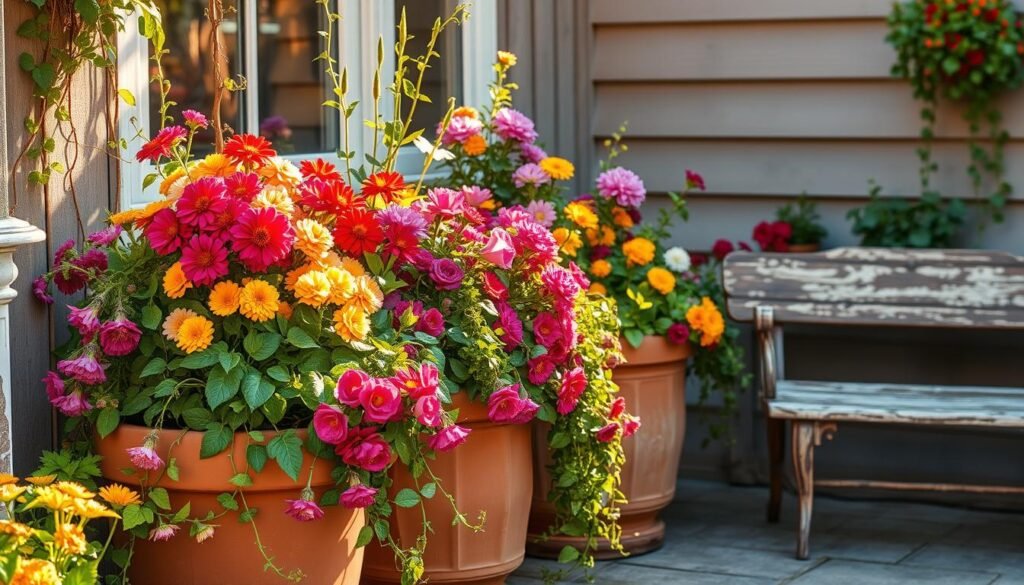
Plant Selection and Arrangement Techniques
When picking plants for your container garden, think about sunlight, temperature, and how they grow. Mix plants with different textures and heights for a beautiful look.
Step-by-Step Container Planting Guide
Begin by adding a layer of drainage material to your containers. Then, fill them with a balanced soil mix. Plant your chosen plants, leaving space for them to grow. Water well and add mulch to keep moisture in.
Drainage Solutions
Good drainage is vital to avoid waterlogged soil. Use broken pottery or small rocks to help with drainage in your containers.
Soil Mixture Recipes
A great soil mix for container gardens includes potting soil, compost, and perlite or vermiculite. These add drainage and aeration.
Maintenance Calendar for Thriving Container Gardens
Regular care is essential for your container gardens to thrive. Water when the top inch of soil is dry, and fertilize monthly during the growing season.
Build Your Own Raised Garden Beds
Building a raised garden bed is a great way to make your garden dreams come true. These beds help with drainage, soil quality, and are easy to reach. They’re perfect for all gardeners, no matter their skill level.
Materials Comparison: Wood vs. Composite vs. Stone
Choosing the right material for your raised garden bed is key. Wood is cheap and easy to work with. Composite materials are durable and need little care. Stone is long-lasting and looks great.
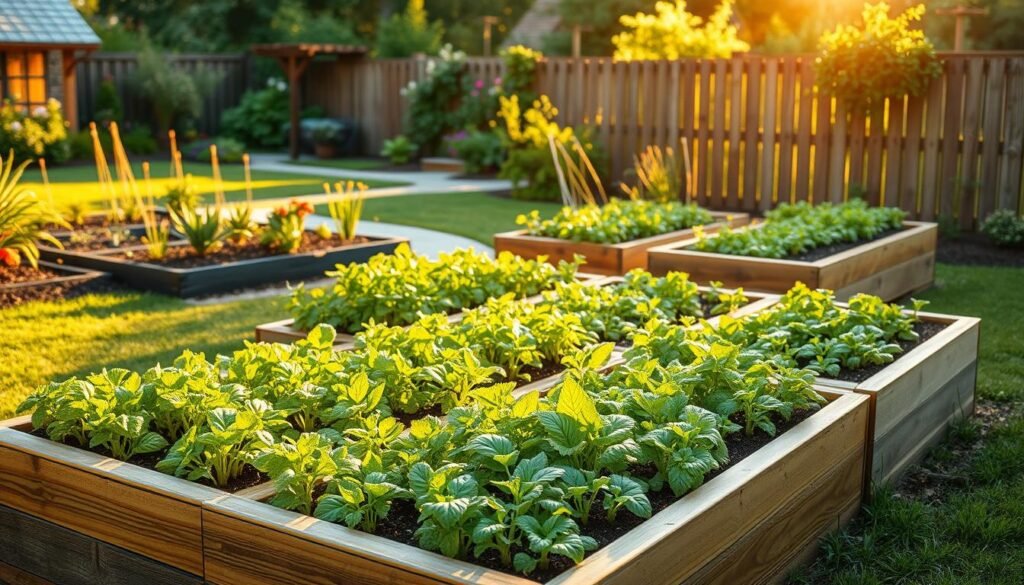
Step-by-Step Construction Process
To start, clean the area and make it level. Cut your material to the right size and build the frame.
Tool Safety and Proper Techniques
Wear safety gear when using tools. Always follow the tool’s instructions for safe use.
Measuring and Cutting Guide
Getting your measurements right is important for a strong bed. Use a tape measure and square for accurate cuts.
Soil Preparation and Planting Strategies
After building, fill the bed with topsoil, compost, and other soil mixers. Think about planting friends and rotating crops to get the most from your garden.
Design Variations for Different Spaces and Needs
Raised garden beds can fit any space or need. Try a tiered design for small areas or a big, easy-to-reach bed for those with mobility issues.
DIY Garden Trellis and Support Structures
Make your garden better with DIY trellises and supports. They help plants grow and make your garden look great.
Simple Stick Trellis Construction
Building a stick trellis is easy. You need straight sticks, twine or wire, and wooden stakes. Make a grid with the sticks and tie them together. It’s great for peas, beans, or climbing flowers.
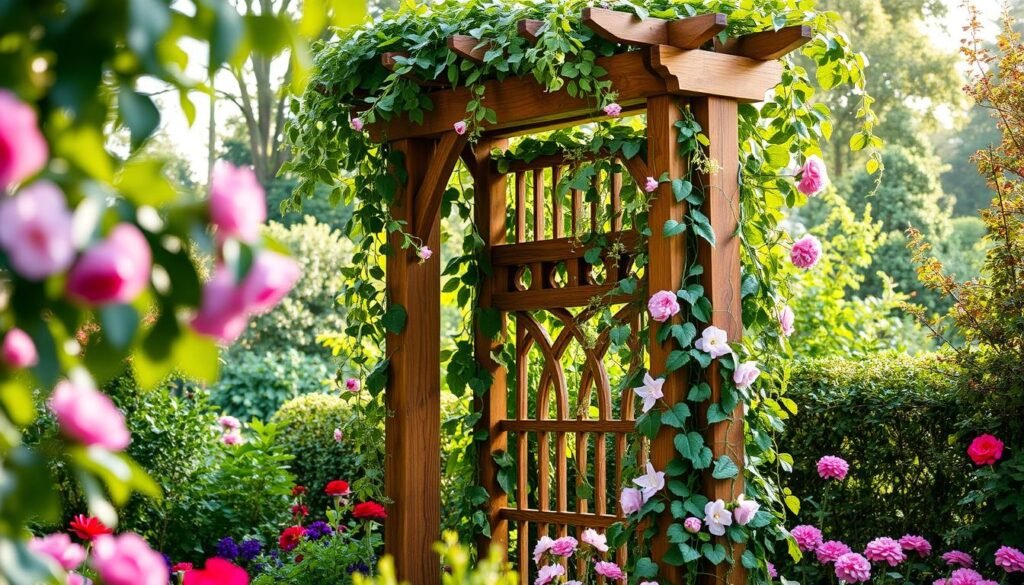
Decorative Lattice Projects for Visual Appeal
Try a lattice trellis for something fancy. You can use pre-made panels or make your own. It’s perfect for climbing roses, clematis, or grapevines.
Vertical Growing Solutions for Small Spaces
Vertical gardening is great for small spaces. Trellises are key in these setups.
Apartment Balcony Options
Apartment dwellers can use a balcony trellis. Choose a small design that fits your space. It’s great for ivy or morning glories.
Space-Saving Designs
There are trellis designs that save space. Look for ones with built-in planters or that act as room dividers.
Plants That Thrive with Vertical Support
Many plants need trellis support. Climbing roses, clematis, peas, and beans are good examples. Pick plants that need support.
Crafting Personalized Garden Pathways
Adding a well-designed pathway to your garden can make it more beautiful and useful. A good pathway not only helps people move around but also makes your garden more interesting to look at.
Material Options and Cost Comparison
Choosing the right material for your pathway is key. You can pick from natural stone, brick, gravel, or wood chips. Each option has its own price and look. For example, natural stone is both strong and pretty but costs more. Gravel is cheaper and simple to put down but needs more upkeep.

Layout and Design Considerations
Think about how your pathway fits with your garden’s design. You can make curves and patterns to make it more interesting.
Creating Curves and Patterns
Curved paths invite you to take a slow walk. Patterns can give your garden a rhythmic feel.
Accessibility Features
Make sure your pathway is easy for everyone to use. Choose materials and designs that are safe for all.
Installation Steps for Different Path Types
How you install your pathway depends on the material. For brick, you need a level base and to space them right. Gravel paths are simpler, just rake them into place.
Maintenance and Longevity Tips
To keep your pathway looking great, regular care is a must. This includes weeding, adding more material, and fixing any damage.
Handmade Garden Decor to Express Your Style
Make your garden stand out with unique, DIY decor. Handmade garden decor lets you show off your style. It makes your outdoor space truly yours.
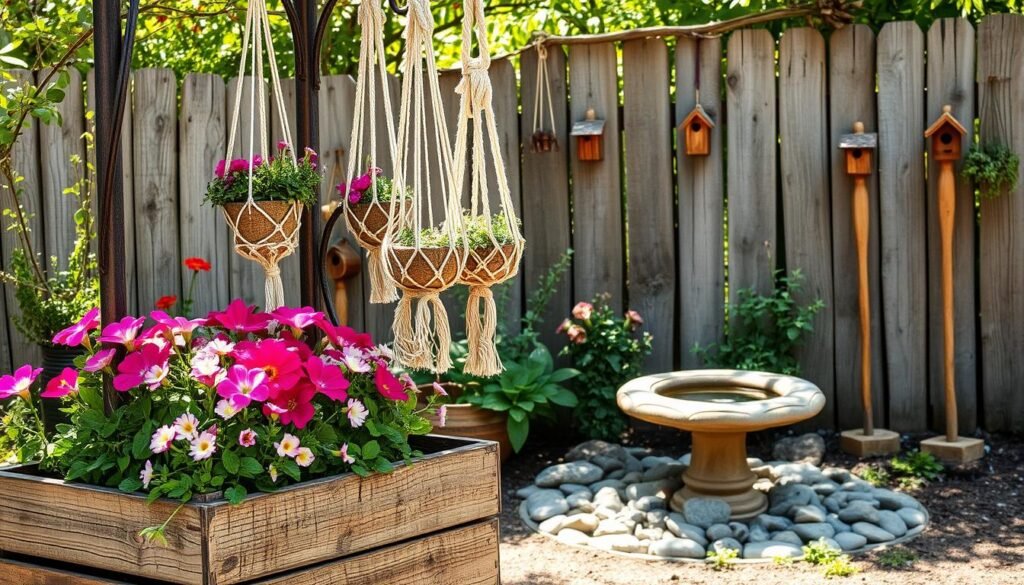
Upcycled Container Projects from Household Items
Turn old items into beautiful plant containers. This adds a personal touch and supports sustainability. It’s a great way to reuse household items.
Use old boots, wooden crates, or vintage pots for unique planters. With some creativity, these items can become beautiful garden decor.
Painted Rock Garden Markers and Decorations
Painted rocks can be both decorative and functional. They add color and personality to your garden. It’s a simple DIY project.
To make painted rock garden markers, pick rocks with flat sides. Clean them well and paint them with weather-resistant paint.
Creating Mosaic Stepping Stones
Mosaic stepping stones add beauty to your garden paths. You can customize them to match your garden’s theme.
Material Selection
Choose durable, weather-resistant materials like ceramic tiles or stone. Make sure they fit your garden’s look.
Design Templates
Start with a simple design or a template. You can find free templates online or create your own. Choose something that fits your garden’s theme.
Weather-Resistant Art Pieces for Year-Round Display
Use weather-resistant materials and techniques for your decor. Apply a protective coating to make them last longer.
Adding handmade garden decor makes your outdoor space more beautiful. It also gives you a sense of accomplishment and inspiration.
Urban Gardening Projects for Limited Spaces
Turning small urban areas into green spaces is both achievable and fulfilling. Urban gardening projects provide creative ways for city folks to grow plants, even in tight spots.
Vertical Wall Gardens for Apartments
Vertical gardening is a big help for apartment dwellers. It lets people grow plants like herbs and succulents on walls, saving floor space. This approach not only brings in plants but also adds a unique look.
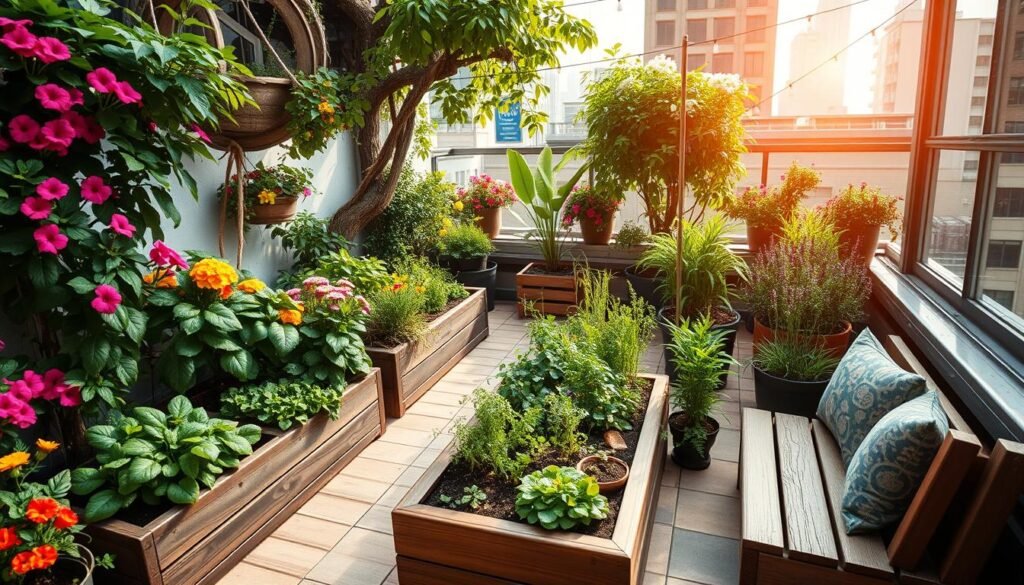
Window Box Construction and Installation
Window boxes are a popular choice for urban gardening. They offer a lovely way to show off plants outside windows. You can make them from wood or recycled plastic.
Securing Boxes Safely
It’s important to make sure window boxes are securely attached. This prevents them from falling and causing harm. Use strong brackets and make sure the boxes are balanced.
Plant Selection for Different Exposures
The type of plants for window boxes depends on the sunlight. Sunny spots are great for flowers and herbs. Shadier areas are better for ferns and plants that like shade.
Balcony Garden Optimization Techniques
Balconies are great for gardening. To make the most of this space, pick the right containers and use vertical gardening. Choose plants that can handle wind and changing sunlight.
Indoor/Outdoor Transitional Garden Spaces
Making a smooth transition between indoor and outdoor gardens is key. Use the same plants in both areas. Also, use big planters that can move between indoors and outdoors.
Sustainable Garden Projects for Eco-Friendly Outdoor Oasis
Starting sustainable garden projects is a smart way to lessen your environmental impact. It also makes your outdoor space more beautiful and healthy. By using eco-friendly gardening methods, you help both yourself and the planet.
DIY Composting Systems You Can Build
Composting is a simple way to cut down on waste and make great soil for your garden. You’ll need a compost bin, “green” materials like food scraps, and “brown” materials like dried leaves. By mixing these and keeping the right balance, you can make excellent compost.
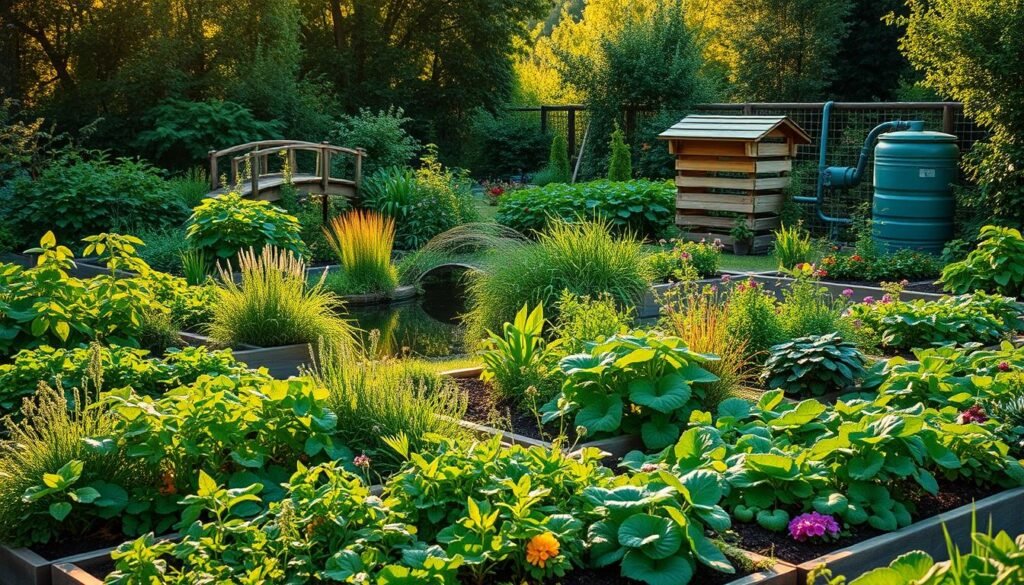
Rainwater Collection Solutions
Collecting rainwater is a smart move to save water. There are many ways to set up rainwater collection in your garden.
Barrel Systems
Using rain barrels is a simple method. Place them under downspouts to catch rainwater for irrigation. This saves water and cuts down on stormwater runoff.
Decorative Options
For a stylish solution, look into decorative rainwater collection systems. They can fit right into your garden’s design. Options range from attractive barrels to complex systems.
Creating Pollinator Gardens and Habitats
Pollinator gardens attract bees, butterflies, and other helpful insects. Plant a mix of flowers that offer nectar and pollen. Using native plants is best, as they attract local pollinators.
Upcycling Materials for Garden Use
Upcycling turns old materials into new garden items. You can make planters from pallets or use broken pottery as markers. It’s a creative way to reduce waste and personalize your garden.
Conclusion: Bringing Your Garden Projects to Life
As you’ve looked at the DIY garden projects in this article, it’s clear you can change your outdoor space. Whether you’re experienced or new to gardening, these ideas can make your outdoor area better. They offer lots of inspiration to improve your outdoor space.
There are many options, from cheap garden projects to green gardening ideas. Adding outdoor DIY elements lets you make a space that shows off your style. So, get ready to start and make your garden dreams come true!
These projects will not only make your outdoor area look good but also a place for relaxation and fun. Start today and see your garden grow into a beautiful retreat.

